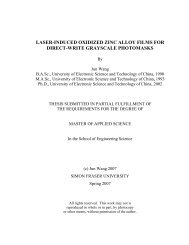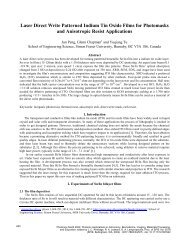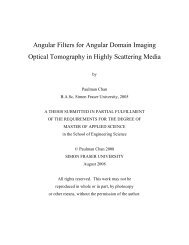Adding Grayscale Layer to Chrome Photomasks - Professor Glenn ...
Adding Grayscale Layer to Chrome Photomasks - Professor Glenn ...
Adding Grayscale Layer to Chrome Photomasks - Professor Glenn ...
Create successful ePaper yourself
Turn your PDF publications into a flip-book with our unique Google optimized e-Paper software.
Figure 19. Transient time response measurement experimental system set up.<br />
The results for the transient response between chrome and Bi/In coated chrome films are shown in Figure 20. In all<br />
cases the laser beam was focused by the 50x objective <strong>to</strong> the 2 µm spot used in the mask writing. For the chrome film,<br />
there is a rapid decrease in the OD from 3 <strong>to</strong> about 1.5 in the first 10 ms of direct exposure <strong>to</strong> a 0.65 W beam and a<br />
gradual linear decrease <strong>to</strong> about 1 OD at 100 ms after exposure. We had previously suggested that this rapid change may<br />
be due <strong>to</strong> a combination of reduction in reflectivity and increased oxidation due <strong>to</strong> conversion <strong>to</strong> a liquid state. At 0.6W<br />
laser power, the Bi/In/Cr film exhibits a similar rapid decrease from about 4.4 OD <strong>to</strong> about 1.58 OD in the first 10 ms<br />
and decreases further <strong>to</strong> about 1.55 at around 20 ms after exposure. The OD then remained at this value unchanged up <strong>to</strong><br />
and beyond 100 ms. At 0.65W laser power, the Bi/In/Cr film shows a different behavior, the OD initially shows a rapid<br />
decrease from 4.1 <strong>to</strong> 1.2 within the first 10 ms of exposure and then decreases linearly at a low rate <strong>to</strong> about 0.85 at<br />
100 ms after exposure. These results follow very closely the behavior of chrome indicating that at 0.65W laser power<br />
the chrome layer’s OD is changing <strong>to</strong>gether with that of the Bi/In film. In contrast, at 0.6W, as soon as the film reaches<br />
its saturated OD of about 1.55 in about 20 ms no further change in OD is observed. The low rate drop at 0.65W is<br />
probably due <strong>to</strong> a significant amount of laser light penetrating the Bi/In layer and oxidizing the chrome. Whereas at<br />
0.6W, the amount of laser power penetrating the Bi/In layer is low enough so that oxidation in the chrome does not<br />
continue after 20 ms. The lack of OD change after 20 ms means a much lower amount of chrome is converted at this<br />
power level. The result also implies that at low enough laser power changes in the OD of the Bi/In layer can be made<br />
without damaging the underlying chrome layer.<br />
5<br />
Optical Density (OD)<br />
4<br />
3<br />
2<br />
1<br />
0<br />
0 0.02 0.04 0.06 0.08 0.1<br />
Time (second)<br />
Bi/In/Cr<br />
0.6W<br />
Cr 0.6W<br />
Bi/In/Cr<br />
0.65W<br />
Cr 0.6W Bi/In/Cr 0.6W Bi/In/Cr 0.65W<br />
Figure 20. Optical density transient time response for conventional chrome and Bi/In coated chrome pho<strong>to</strong>masks.










